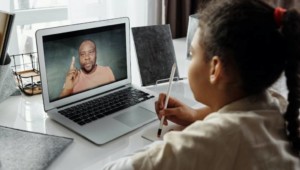Blended Learning Update
Blended learning combines multiple modes of instruction to create a rapid and efficient path to mastery. The term has been used for years in corporate training and is the architectural foundation of the largest and most efficient learning organization in the world—the U.S. military.
In the K-12 context, my definition of blended learning as
1) shifting instructional responsibility for at least a portion of the day to an online or computer-based environment
2) to boost learning, staffing, and/or facilities productivity.
In a recent EduClarity post, Carmel Henderson describes a teacher-centric tech-infused classroom. It’s sounds engaging but it’s probably not blended, at least not using my definition.
Rocketship, an elementary network, is a partial blend. John Danner has a good description here. Here’s my summary. The use of a learning lab stretches the budget and allows a long day/year, higher teacher salaries, and sustainable schools (even in CA). In the learning lab, kids benefit from adaptive tools and move at their own pace but the rest of the day is pretty traditional. They are making plans for expanding the time in the learning lab and improving the link between the lab and classroom.
Blended learning has been common in alternative education especially credit recovery. AdvancePath, a dropout prevention network (where I’m a director), features online curriculum, competency-based progress, and the support of two lead teachers in an Internet café-like setting.
Nearly two million high school students are blending their own learning by taking a mix of online and onsite courses (it’s more than 3m if you include home schoolers).
John Watson, Keeping Pace author, estimates that almost half of U.S. school districts have or are planning online and blended offerings. Most post-secondary experiences will soon be blended for cost and/or convenience.
This year we’re seeing the expansion of online learning platforms used in new and existing brick and mortar schools: K12 Flex schools and Connections Academy (both edReformer advocacy partners) with Alvarez & Marsal in turnaround situations
Yesterday I described a fully virtual elementary environment where students move at their own pace with the support of a learning coach and an online teacher.
As tools and platforms get more sophisticated we’ll see blends that increasingly customize the rate and mode of learning experience for every student. Smart recommendation engines will produce individualized playlists as piloted at School of One.
There will be a lot of discussion of blended learning at iNACOL’s Virtual School Symposium in Scottsdale next month (I’m a director).
By decade end, most secondary students will do most of their learning online and most will attend a school that is at least partially blended. The shift from print to digital and classes to students will allow more students to graduate from high school in three years with one year of college credit.
As Chris Sturgis suggested this morning, innovative blends will also serve alternative and special needs students.
City Prep, is a NYC-based blended learning provider I lead, is excited about helping communities develop more effective and more sustainable schools.






0 Comments
Leave a Comment
Your email address will not be published. All fields are required.